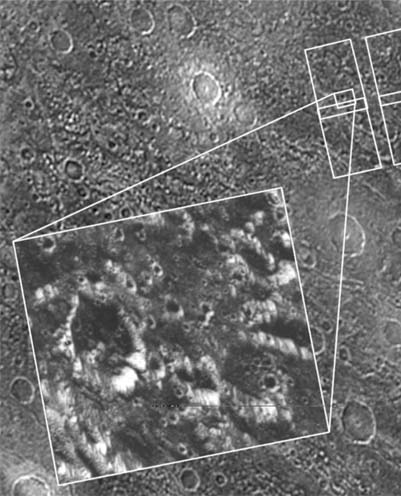Ganymede

This is a natural color view of Ganymede from the Galileo spacecraft during its first encounter with the satellite. North is to the top of the picture and the sun illuminates the surface from the right. The dark areas are the older, more heavily cratered regions and the light areas are younger, tectonically deformed regions. The brownish-gray color is due to mixtures of rocky materials and ice. Bright spots are geologically recent impact craters and their ejecta. The finest details that can be discerned in this picture are about 13.4 kilometers across. The images which combine for this color image were taken beginning on June 26, 1996.
 | These images demonstrate the dramatic improvement in the resolution of pictures that NASA's Galileo spacecraft is returning compared to previous images of the Jupiter system. |
The frame at left was taken by the Voyager 2 spacecraft when it flew by in 1979, with a resolution of about 1.3 kilometers (0.8 mile) per pixel. The frame at right showing the same area was captured by Galileo during its first flyby of Ganymede on June 27, 1996; it has a resolution of about 74 meters (243 feet) per pixel, more than 17 times better than that of the Voyager image.
In each of the above frames, north is to the top, and the sun illuminates the surface from the lower left nearly overhead (about 77 degrees above the horizon). The area shown, at latitude 10 degrees north, 167 degrees west, is about 35 by 55 kilometers (25 by 34 miles). The image was taken June 27 when Galileo was 7,448 kilometers (4.628 miles) away from Ganymede.
 | View of the Galileo Regio region on Ganymede showing fine details of the Galileo image fit into the larger scale, but much lower resolution view of the region taken 17 years earlier by Voyager. The broad curved furrow patterns are characteristic of the darker regions of this moon. North is to the top of the picture and the sun illuminates the surface from almost overhead in the Galileo picture. |
Ganymede is one of the four largest moons of Jupiter. These moons are called the "Galilean moons" because they were first observed by Galileo.
Ganymede is in fact the largest moon in the solar system, even exceeding the planets Mercury and Pluto in size. It orbits at about 15 Jupiter radii . It's overall density is only about 2000 kg/m^3, suggesting that it must contain a lot of ice throughout. It is modeled as having an iron/iron sulfide core like Io and Europa, but it is evidently smaller in proportion to the volume since the density is much lower. As the images show, it is cratered extensively. The less-cratered regions are presumed to be younger surfaces.
The dark region at the top of the first image is called Galileo Regio. It is seen to be one of the older parts, original icy highlands. The brigher, younger areas can be considered to be like the Moon's maria, except formed by upwelling water rather than the upwelling molten lava on the Moon. The extensive system of grooves and ridges has no counterpart on the Moon, and are evidence of some early tectonic activity.
Galileo discovered a weak magnetosphere around Ganymede, the first moon to show a magnetic field.
Jupiter Concepts
Solar System Illustration
Solar System Concepts
References
Chaisson & McMillan,
Ch 11.
| HyperPhysics********** Astrophysics | R Nave |